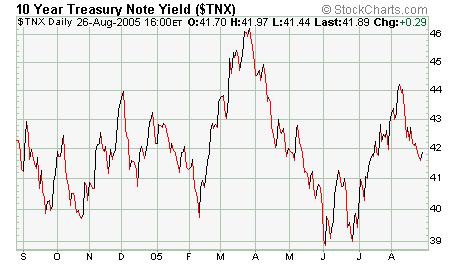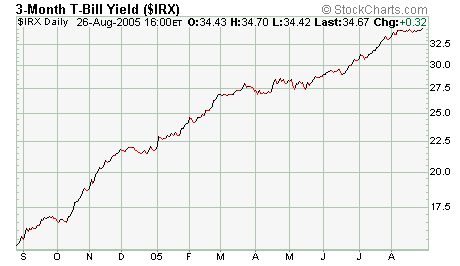Is Greenspan intent on deflating the housing bubble? If so, watch out.
Long-Term Rates
Nothing too interesting going on here. After climbing fairly relentlessy for almost a month and a half, the rate on the 10-Year Treasury turned right around and started heading back down.

There is little at this time to indicate that long rates will stop bouncing around within the current trading range. Given this, along with the fact that they are now smack in the middle of where they’ve been over the past year, the recent long-term rate changes don’t appear likely to have much effect on housing.
Short-Term Rates
Things were a little more lively in the world of short rates. Fed Chairman Greenspan gave an unusally blunt speech in which he characterized the housing market as an “imbalance.” More dramatic, to me, was this statement:
Our forecasts and hence policy are becoming increasingly driven by asset price
changes.
If true, this is a big deal. Up until now, the Fed has looked primarily at consumer price inflation in deciding when to tighten the monetary spigots. Increasing values of assets such as stocks, bonds, and houses were not considered by our central bank to be their concern. This should be pretty obvious from the fact that the Fed was wildly cutting rates even as home prices in Southern California were skyrocketing.
Now it seems that our soon-to-be-ex-Chairman is coming around to the idea that asset prices are actually part of the monetary policy picture. Such a philosophy would translate directly to higher short-term rates. After all, our recent benign consumer price inflation could justify fairly low rates—but “inflation” in the housing market is anything but benign!
In June I opined that the Fed might stop tightening fairly soon, citing slowing economic indicators and falling long-term rates. However, since that time, long rates have risen and economic indicators such as the ISM Purchasing Managers Index have had a burst of strength. Given this added economic elbow room and Greenspan’s newfound concern for asset prices, short rates could rise more than I initially expected.
In all honesty, I must add that I am skeptical as to whether the Fed will really “walk
the talk” when it comes to actually setting monetary policy. However, it was quite interesting to hear Greenspan even acknowledge the concept that the Fed should set policy based at least in part on asset prices. And it certainly opens up the door to a Fed funds rate that is higher than the markets expect.
In any event, short-term bond yields held pretty steady throughout the month. We’ll see whether Greenspan’s tough talk has an effect.

Conclusion
Is Greenspan actually intent on deflating the housing bubble? If so, watch out. The rate increases necessary to cool down blazing markets like Miami could really pack a wallop on an already-cooling market like San Diego.
I guess we will know soon enough. For the time being, however, the credit markets are behaving themselves and not yet causing any problems for San Diego housing.
Treasury yield charts courtesy of StockCharts.com.
